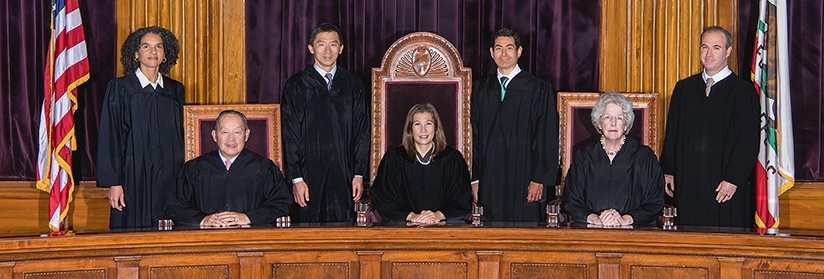
California Supreme Court. (Photo: courts.ca.gov)
California Supreme Court Removes Tax Measure from Statewide Ballot
Either the entire initiative is invalid, or it is not
By Chris Micheli, June 22, 2024 5:37 pm
In Legislature v. Weber (Hiltachk, Real Party in Interest), S281977, the California Supreme Court unanimously decided to remove a qualified initiative measure (commonly referred to as the “Taxpayer Protection Act” or “TPA”) from the statewide ballot for November 5, 2024. The state high court’s 7-0 decision was authored by Justice Liu.
According to the Court, “The only question before us is whether the measure may be validly enacted by initiative.” To this question, the court gave a resounding “no.” They explained, that, “after considering the pleadings and briefs filed by the parties and amici curiae as well as the parties’ oral arguments, we conclude that Petitioners have clearly established that the challenged measure would revise the Constitution without complying with the appropriate procedure.”
So, while “the changes proposed by the TPA are within the electorate’s prerogative to enact, … because those changes would substantially alter our basic plan of government, the proposal cannot be enacted by initiative.” The Court explained that the voters’ right to enact a TPA-type measure “is instead governed by the procedures for revising our Constitution.”
As a result of the Supreme Court’s decision, it issued a peremptory writ of mandate that directs the California Secretary of State “to refrain from taking any steps to place the TPA on the November 5, 2024 election ballot or to include the measure in the voter information guide.” Because this matter is only of state issues, there is no further appeal.
In explaining its decision, the high court initially wrote that it “typically review[s] constitutional challenges to an initiative after an election in order to avoid disrupting the electoral process and the exercise of the franchise. (Brosnahan v. Eu (1982) 31 Cal.3d 1, 4.) But preelection review is proper for challenges that go ‘to the power of the electorate to adopt the proposal in the first instance.’ (Legislature v. Deukmejian (1983) 34 Cal.3d 658, 667.)”
In this case, the Court said a “postelection review would be more challenging than in a typical case because of the TPA’s rollback provisions.” Included within the TPA are provisions that would void any state or local “tax or exempt charge” adopted after January 1, 2022 and prior to the TPA’s effective date if it was “not adopted in compliance with” the newly proposed requirements under the TPA, unless it were reenacted with voter approval within one year of the TPA’s effective date. On this basis, the high court said that “we find that preelection review is appropriate in this matter.”
With a preelection challenge on the basis of a revision (rather than an amendment, which is permitted by initiative), the Court said “[o]ur prior decisions have made it clear that to find such a revision, it must necessarily or inevitably appear from the face of the challenged provision that the measure will substantially alter the basic governmental framework set forth in our Constitution. (Legislature v. Eu (1991) 54 Cal.3d 492, 510.)”
Note that a revision to the California Constitution may be proposed either by the required vote of the Legislature (2/3 of each house) or by a constitutional convention (proposed by the Legislature and approved by the voters). As a result, the Court was determining in this case whether the TPA was an amendment to the state Constitution (which can be done by initiative) or a revision to the state Constitution (which cannot be done by voter initiative).
According to the Supreme Court, “the distinction between amendment and revision dates back to the original 1849 Constitution.” And the provisions of the state Constitution show “that the amendment/revision distinction long predates the appearance of the initiative process in California.” The initiative and the other two forms of direct democracy were adopted by voters and added to the state Constitution in the early 1900s.
The first major preelection challenge that resulted in removing a qualified measure from the state ballot on the basis that the voter initiative was an impermissible revision occurred in 1948. “We held in McFadden that a proposed initiative was an impermissible revision because its effect would have been to “substantially alter the purpose and to attain objectives clearly beyond the lines of the Constitution as now cast” rather than working “ ‘within the lines of the original instrument’ ” to achieve “ ‘an improvement or better carry out the purpose for which it was framed.’”
Voters in California at the November 1962 general election adopted Prop. 7, which was a constitutional amendment which the Legislature approved to permit the Legislature to submit constitutional revisions, as well as amendments, to the electorate for approval.
According to the high court, “the numerous past decisions of this court that have addressed this issue all have indicated that the type of measure that may constitute a revision of the California Constitution is one that makes ‘far reaching changes in the nature of our basic governmental plan’.” The Court also wrote, “stated in slightly different terms, that ‘substantially alter[s] the basic governmental framework set forth in our Constitution” is the test for determining whether an initiative is a revision.
Moreover, “when evaluating whether a voter initiative constitutes a valid amendment or invalid revision, we examine the challenged measure in its entirety. (Amador Valley, 22 Cal.3d at p. 221.)” The Court also said that, “while a single provision of an initiative may constitute a revision standing alone (see Raven, 52 Cal.3d at pp. 340–341), a proposed initiative may also be revisionary based on its combined effects.”
Another interesting issue that the Court ruled on, and some legal commentators wondered, “while in post-enactment review, courts may sometimes sever invalid provisions from valid ones, there is no precedent for granting severance as a remedy in the preelection context.” Because of this, the Court explained that it would not sever any unconstitutional provisions and leave the remaining provisions to be placed on the ballot.
In other words, either the entire initiative is invalid, or it is not. There is not severability prior to a vote by the electorate. Instead, the state’s courts may sever an unconstitutional provision of an approved initiative, only after adoption by the voters in a post-election legal challenge.
The central focus on the Court’s ruling that the TPA was a revision, rather than an amendment, focused on the taxing authority, primarily of the Legislature, but also of local governments. “From the state’s founding, the Legislature has had broad authority to levy taxes…So central is the authority to levy taxes that tax legislation is exempt from referendum.”
The high court has previously discussed (Wilde case, for example) tax measures being exempt from the referendum. As the state Constitution provides in Article II, the referendum power is subject to certain exceptions, including “statutes providing for tax levies or appropriations for usual current expenses of the State” are exempt from referendum.
Ultimately, the high court ruled that “We think it clear that a voter approval requirement for any new state tax measure would constitute a significant ‘interference with the administration of [the Legislature’s] fiscal powers and policies.’ (Geiger, 48 Cal.2d at p. 840.)”
The high court explained that, “The Constitution thus directs that the Legislature’s fiscal decisions must be effective immediately. This is particularly important when changes in revenue or appropriations are needed to respond to state or local emergencies. Petitioners and amici curiae note multiple instances in which the Legislature has used this authority to respond swiftly to natural and financial disasters.”
As a result of this status in the state Constitution, according to the Court, “By requiring the electorate to approve any new tax or any change in the use of any special tax revenue previously approved by the voters, the TPA would preclude the state from raising new revenue or redirecting any existing special tax revenue in light of unforeseen events, until after a statewide election.”
The proponents of the TPA argued that the measure “simply moves the taxing power from the Legislature to the electorate, thereby keeping that power within the legislative branch.” The Court responded, “That may be true, but it is also true that such a change would significantly alter the legislative process and framework for exercising the taxing power. The Legislature’s duty to ensure the welfare of our state and its people includes responsibility for fiscal planning, both short-term and long-term, that the Legislature historically has had authority to exercise without voter approval.”
The Court held that requiring any new or higher tax levy to undergo voter approval would significantly alter the existing constitutional balance between direct democracy and representative democracy, “with reverberations throughout the framework of our government.” Therefore, “we conclude that the TPA would substantially transform the process for enacting new statewide tax legislation that has existed since the state’s founding and that this transformation weighs significantly in favor of finding that the TPA would effect a constitutional revision.”
The second part of the decision dealt with the argument that the TPA shifts power between the executive branch and the legislative branch in three ways. And the Court held that the TPA “would significantly rework the current balance between legislative and executive functions at the state and local level.” The Court said that the TPA’s proponents do not dispute the significance of these changes.
For example, “at oral argument, Proponent said the TPA would accomplish a ‘rollback to a condition that existed decades ago, prior to the Legislature deciding that it was going to empower executive agencies to raise revenue.’ Indeed, Proponent explained that a purpose of the TPA is to ‘restore’ California to a time before modern administrative practice, when ‘all fees were approved, proposed, and enacted by statute’.” The Court obviously found that this would result in a change in the fundamental structure of our state government.
The Court emphasized that, “what we decide here is only whether the changes would substantially alter the current constitutional scheme, in which legislative delegation of power to administrative agencies is permissible, widespread, and fundamental to the operation of government.” And the high court said that shifting the authority to impose these fees or other charges from administrative agencies to the Legislature would materially reshape the nature and volume of the Legislature’s everyday work and its overall function and efficacy in our system of governance.
In addition, the Court stated, “we also find the TPA’s expansion of the referendum power to cover all agency fines and fees that qualify as exempt charges to be a significant change.” As the justices explained, the referendum ‘poses a distinct potential for disruption that sets it apart from the ordinary legislative process.’ (Wilde, at p. 1122.) For that reason, ‘statutes providing for tax levies or appropriations’ have been excluded from the referendum power since its inception.”
The Wilde decision ruled that Article II, section 9 provides a number of exemptions from the referendum because these exemptions “reflect a recognition that in certain areas, legislators must be permitted to act expediently, without the delays and uncertainty that accompany the referendum process. All of the exemptions — for urgency statutes, statutes calling elections, and statutes providing for tax levies or appropriations for usual current expenses of the state — are for ‘measures having special urgency, a delay in the implementation of which could disrupt essential governmental operations’. (Wilde, at pp. 1122–1123.)”
The Court found it “significant” that, under the TPA, every nontax government fee or charge would be subject to referendum, including those necessary to fund essential services. “All state and local charges, no matter how essential, would be subject to delays that could be triggered by a small minority of voters in a given jurisdiction.” As a result, “we conclude that the TPA’s requirement that all statewide nontax government charges be legislatively enacted would, like the TPA’s state tax voter-approval requirement, effect a significant change in how our state government raises revenue.”
The high Court explained the state Constitution gives local governments broad authority over their own operations to fulfill their constitutional mandate to provide public services. However, the TPA “would substantially overhaul how local governments go about ensuring that everyday services are properly provided. In sum, the TPA would affect all local revenue measures — big or small, essential or nonessential — to an extent that leaves no aspect of government untouched.”
Fundamentally, the Supreme Court explained that the basic plan of our state government was set forth in the 1879 Constitution, and the state’s voters have the power to modify their government. However, it must be done “through the appropriate procedures.” The Court said that the TPA, “taken as a whole, would accomplish a revision. Whether any individual component of the TPA would constitute a revision standing alone is a question we do not answer here.”
In conclusion, the Court said the TPA would clearly “accomplish such far reaching changes in the nature of our basic governmental plan as to amount to a revision” of the Constitution. (Amador Valley, 22 Cal.3d at p. 223.) And, “the measure exceeds the scope of the power to amend the Constitution via citizen initiative. (Art. II, § 8, subd. (a).) It is within the people’s prerogative to make these changes, but they must be undertaken in a manner commensurate with their gravity: through the process for revision set forth in article XVIII of the Constitution.”
- Management of Unclaimed Property - December 30, 2025
- Petitions and Responses in Arbitration - December 29, 2025
- Wage Garnishment in California - December 29, 2025





So the court ruled that the power of the people is limited. However, the legislature and unelected entities throughout California can take whatever they want from the people. I don’t like it.
Now that this has been done, watch how fast our taxes go up!
$5.00 gas tax for environmental purposes? Expect it soon and don’t worry, Gavin will be blaming the gas companies for “gouging the taxpayers”.
50% income tax rate for the workers of California? Bank on it. This court decision just gave the political class the green light to steal every red cent we earn.